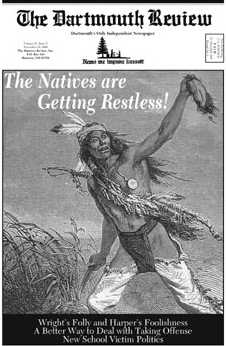Depictions of Native Americans often reflected what artists wanted to see, a Huntington display shows.
As westward expansion met resistance from the Indians whose lands and resources were being taken, darker imagery began to emerge. In a mid-19th century print, "Death Whoop," artist Seth Eastman depicts an Indian scalping a cowboy. Hight calls it an "inflammatory image," which was unfortunately reproduced on the title page of a series of books prepared for Congress. And, of course, there is a print of Custer's last stand, showing Custer brave and stalwart with his handful of men as Lakotas and Cheyennes close in on them—a scene now considered bogus. But such heroic moments were popular in saloons, and this poster-sized version, after a painting by Cassily Adams, was made in 1896 to advertise Budweiser beer.

Comment: Now you know one of the sources for the inflammatory cover of last December's Dartmouth Review.


No comments:
Post a Comment